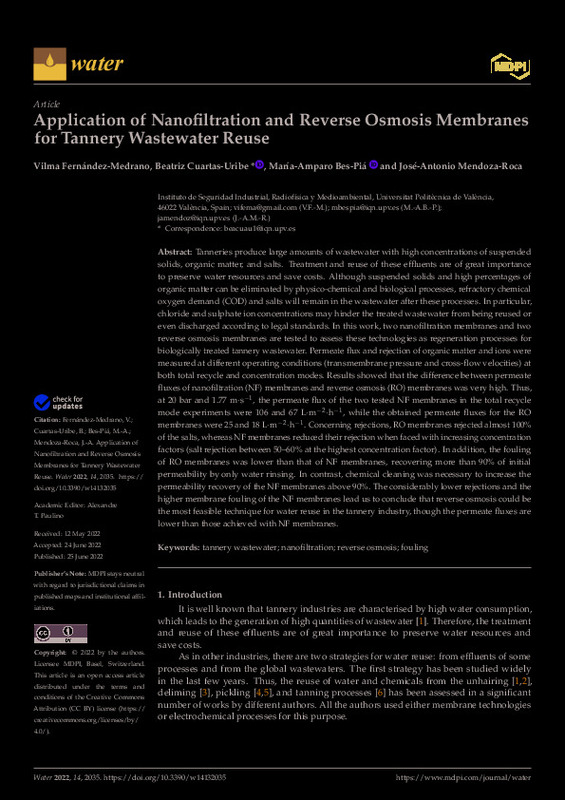JavaScript is disabled for your browser. Some features of this site may not work without it.
Buscar en RiuNet
Listar
Mi cuenta
Estadísticas
Ayuda RiuNet
Admin. UPV
Application of Nanofiltration and Reverse Osmosis Membranes for Tannery Wastewater Reuse
Mostrar el registro sencillo del ítem
Ficheros en el ítem
| dc.contributor.author | Fernandez-Medrano, Vilma
|
es_ES |
| dc.contributor.author | Cuartas Uribe, Beatriz Elena
|
es_ES |
| dc.contributor.author | Bes-Piá, M.A.
|
es_ES |
| dc.contributor.author | Mendoza Roca, José Antonio
|
es_ES |
| dc.date.accessioned | 2023-05-12T18:01:49Z | |
| dc.date.available | 2023-05-12T18:01:49Z | |
| dc.date.issued | 2022-07 | es_ES |
| dc.identifier.issn | 2073-4441 | es_ES |
| dc.identifier.uri | http://hdl.handle.net/10251/193313 | |
| dc.description.abstract | [EN] Tanneries produce large amounts of wastewater with high concentrations of suspended solids, organic matter, and salts. Treatment and reuse of these effluents are of great importance to preserve water resources and save costs. Although suspended solids and high percentages of organic matter can be eliminated by physico-chemical and biological processes, refractory chemical oxygen demand (COD) and salts will remain in the wastewater after these processes. In particular, chloride and sulphate ion concentrations may hinder the treated wastewater from being reused or even discharged according to legal standards. In this work, two nanofiltration membranes and two reverse osmosis membranes are tested to assess these technologies as regeneration processes for biologically treated tannery wastewater. Permeate flux and rejection of organic matter and ions were measured at different operating conditions (transmembrane pressure and cross-flow velocities) at both total recycle and concentration modes. Results showed that the difference between permeate fluxes of nanofiltration (NF) membranes and reverse osmosis (RO) membranes was very high. Thus, at 20 bar and 1.77 m s¿1, the permeate flux of the two tested NF membranes in the total recycle mode experiments were 106 and 67 L m¿2 h¿1, while the obtained permeate fluxes for the RO membranes were 25 and 18 L m¿2 h¿1. Concerning rejections, RO membranes rejected almost 100% of the salts, whereas NF membranes reduced their rejection when faced with increasing concentration factors (salt rejection between 50¿60% at the highest concentration factor). In addition, the fouling of RO membranes was lower than that of NF membranes, recovering more than 90% of initial permeability by only water rinsing. In contrast, chemical cleaning was necessary to increase the permeability recovery of the NF membranes above 90%. The considerably lower rejections and the higher membrane fouling of the NF membranes lead us to conclude that reverse osmosis could be the most feasible technique for water reuse in the tannery industry, though the permeate fluxes are lower than those achieved with NF membranes. | es_ES |
| dc.description.sponsorship | This research was funded by Universitat Politecnica de Valencia (project ref: PAID-06-10-2269). | es_ES |
| dc.language | Inglés | es_ES |
| dc.publisher | MDPI AG | es_ES |
| dc.relation.ispartof | Water | es_ES |
| dc.rights | Reconocimiento (by) | es_ES |
| dc.subject | Tannery wastewater | es_ES |
| dc.subject | Nanofiltration | es_ES |
| dc.subject | Reverse osmosis | es_ES |
| dc.subject | Fouling | es_ES |
| dc.subject.classification | INGENIERIA QUIMICA | es_ES |
| dc.title | Application of Nanofiltration and Reverse Osmosis Membranes for Tannery Wastewater Reuse | es_ES |
| dc.type | Artículo | es_ES |
| dc.identifier.doi | 10.3390/w14132035 | es_ES |
| dc.relation.projectID | info:eu-repo/grantAgreement/UPV//PAID-06-10-2269/ | es_ES |
| dc.rights.accessRights | Abierto | es_ES |
| dc.contributor.affiliation | Universitat Politècnica de València. Escuela Técnica Superior de Ingenieros Industriales - Escola Tècnica Superior d'Enginyers Industrials | es_ES |
| dc.description.bibliographicCitation | Fernandez-Medrano, V.; Cuartas Uribe, BE.; Bes-Piá, M.; Mendoza Roca, JA. (2022). Application of Nanofiltration and Reverse Osmosis Membranes for Tannery Wastewater Reuse. Water. 14(13):1-16. https://doi.org/10.3390/w14132035 | es_ES |
| dc.description.accrualMethod | S | es_ES |
| dc.relation.publisherversion | https://doi.org/10.3390/w14132035 | es_ES |
| dc.description.upvformatpinicio | 1 | es_ES |
| dc.description.upvformatpfin | 16 | es_ES |
| dc.type.version | info:eu-repo/semantics/publishedVersion | es_ES |
| dc.description.volume | 14 | es_ES |
| dc.description.issue | 13 | es_ES |
| dc.relation.pasarela | S\468180 | es_ES |
| dc.contributor.funder | Universitat Politècnica de València | es_ES |
| dc.subject.ods | 06.- Garantizar la disponibilidad y la gestión sostenible del agua y el saneamiento para todos | es_ES |
| upv.costeAPC | 1513,44 | es_ES |








